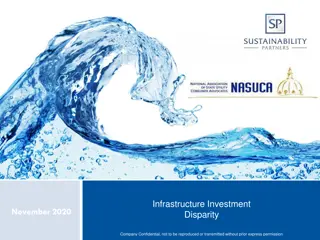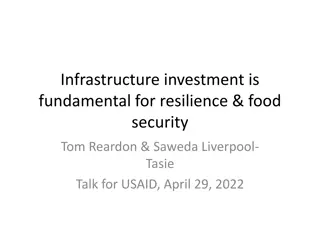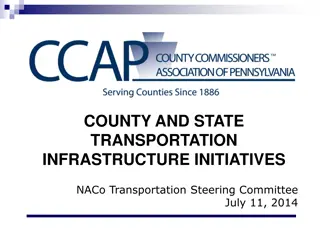
Infrastructure and Its Components
Infrastructure encompasses essential physical structures and utilities vital for societal functionality, including transportation systems, communication networks, and basic facilities like schools and hospitals. Explore the significance and key components of infrastructure such as social services, physical systems like road transport, and environmental safeguards.
Download Presentation

Please find below an Image/Link to download the presentation.
The content on the website is provided AS IS for your information and personal use only. It may not be sold, licensed, or shared on other websites without obtaining consent from the author. If you encounter any issues during the download, it is possible that the publisher has removed the file from their server.
You are allowed to download the files provided on this website for personal or commercial use, subject to the condition that they are used lawfully. All files are the property of their respective owners.
The content on the website is provided AS IS for your information and personal use only. It may not be sold, licensed, or shared on other websites without obtaining consent from the author.
E N D
Presentation Transcript
Basic or internal structure or foundation Infrastructure has come to connote buildings, means of transportation and communication as well as other necessary basic utilities and facilities. Eg., Schools , Hospitals., etc
PHYSICAL (ROAD TRANSPORT, WATER DISPOSAL) SERVICES SOCIAL (EDUCATION AND TRAINING) ENVIRONMETAL (SAFEGUARD ENVIRONMENTAL)
PHYSICAL INFRASTRUCTURE Physical infrastructure refers to the basic physical structures required for an economy to function and survive, such as transportation networks, a power grid and sewerage and waste disposal systems. It contains development of roads, water, drainage, electricity, transport and so an .
SERVICES INFRASTRUCTURE: Infrastructure services are foundational information technologies that are offered as a service such that they are supported and managed. This spares customers the cost, complexity and risk of managing their own digital infrastructure.
SOCIAL INFRASTRUTURE: They concern with the supply of such services as to meet the basic needs of a society. In simple words, social infrastructures refer those basic services such as education and training. It also includes health and sanitation, drinking water, housing, sewerage.
ENVIRONMENTAL INFRASTRUTURE: Environmental infrastructure provides cities and towns with water supply, waste disposal, and pollution control services. These municipal works serve two important purposes: they protect human health and safeguard environmental quality.
MAJOR OBJECTIVES TO DEVELOP INFRASTRUCTURE: BUILD LOCAL CAPACITIES - Training of semi skilled construction workers and masons in hazard resistant construction. SUPPORT THE ENVIRONMENT Use of alternative technologies for reconstruction . Eg.,coinpressed stabilized earth blocks, rammed earth technology..etc.,
INVOLVE LOCAL COMMUNITIES- Owner driven and participatory construction. HELP REBUILD LOST LIVELIHOODS- Customized designs to suit individual housing and livelihood requirements.
Loss of infrastructure may have significant indirect and secondary costs that directly affect the poor. Access to infrastructure for the rural poor, primarily irrigation and transportation, increases, income that enables the poor to manage risk.






















